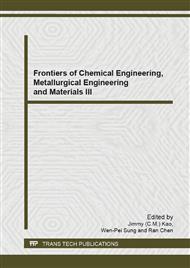[1]
D.T. Zhu, Review and Comment of Development about BUM and Substrate Materials of BUM (in Chinese), Printed Circuit Board Inf. 6 (2003) 3-10.
Google Scholar
[2]
K. Brodersen, D. Tartler, B. Danzer, Scrap of electronics: A challenge to recycling activities, IEEE International Symposium on Electronics & the Environment (1994) 174-176.
DOI: 10.1109/isee.1994.337310
Google Scholar
[3]
J. Linton, Electronic products at their end-of-life: option and obstacles, J. Electron. Manuf. ,9 (2000) 29-40.
Google Scholar
[4]
J. Li, HZ Lu, J. Guo, ZM Xu, YH Zhou, Recycle technology for recovering resources and products from waste printed circuit boards, Environ. Sci. Technol. 41(2007), 1995–(2000).
DOI: 10.1021/es0618245
Google Scholar
[5]
D. Bleiwas, T. Kelly, Obsolete Computers, Gold Mine, or High-Tech Trash?, Resource Recovery from Recycling Report, United States Geological Survey (2001. 7).
DOI: 10.3133/fs06001
Google Scholar
[6]
J.B. Legarth, Environmental decision making for recycling options, Resources Conservation and Recycling 19 (1997) 109-135.
DOI: 10.1016/s0921-3449(96)01186-x
Google Scholar
[7]
X.H. Bi, B. Simoneit, The major components of particles emitted during recycling of waste printed circuit boards in a typical e-waste workshop of South China, Atmospheric Environment 44 (2010) 4440-4445.
DOI: 10.1016/j.atmosenv.2010.07.040
Google Scholar
[8]
H. Li, L. Yu, G. Sheng, J. Fu, P. Peng, Severe PCDD/F and PBDD/F pollution in air around an electronic waste dismantling area in China, Environ. Sci. Technol. 41 (2007) 5641–5646.
DOI: 10.1021/es0702925
Google Scholar
[9]
XH Bi, G. Thomas, K. Jones, WY Qu, GY Sheng, F. Martin, JM Fu, Exposure of Electronics Dismantling Workers to Polybrominated Diphenyl Ethers, Polychlorinated Biphenyls, and Organochlorine Pesticides in South China, Environ. Sci. Technol. 41 (2007).
DOI: 10.1021/es070346a
Google Scholar
[10]
S. Zhang, E. Forssberg, Mechanical separation-oriented characterization of electronic scrap, Resour. Conserv. Recycle 21 (1997) 247–269.
DOI: 10.1016/s0921-3449(97)00039-6
Google Scholar


